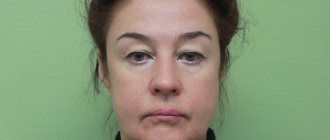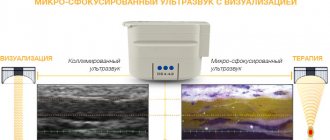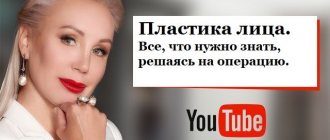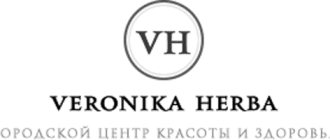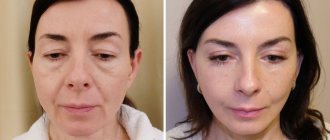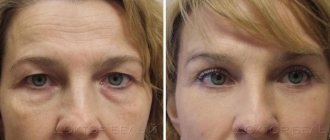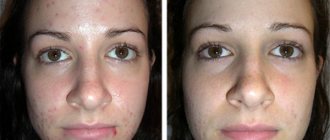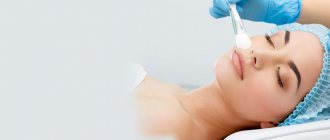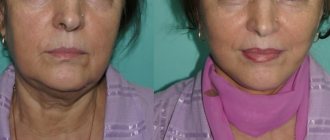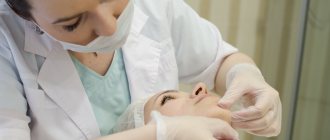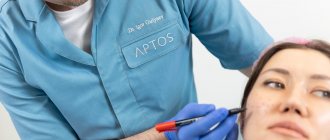- home
- Cosmetology
- Ultrasound therapy
The procedure is performed by esthetician-cosmetologist A.V. Morozova.
Three factors act on the human body during ultrasound therapy (UT): mechanical, thermal and physico-chemical. The mechanical factor manifests itself in vibration “micro-massage” of tissues at the cellular level. In this case, there is an increase in the permeability of cell membranes, an increase in the protective function - an obstacle to the transition from blood to tissues and from tissues to blood of foreign substances; the constancy of the composition and physicochemical properties of tissue fluid is ensured, the implementation and regulation of metabolic processes between blood and tissues is controlled. UST reduces the viscosity of intracellular fluid, changes microcirculation and collagen structure of tissues, loosening it, and increases the functional activity of blood cells. UST stimulates the functions of cellular elements and the cell as a whole.
The thermal effect is caused by the conversion of absorbed mechanical energy of ultrasonic waves into heat. An increase in temperature leads to a change in the activity of enzymes, the rate of biochemical reactions and diffusion processes, and an improvement in microcirculation.
The physicochemical factor manifests itself in changes in physicochemical, biochemical and biophysical processes. Metabolism in tissues is activated, tissue pH changes, histamine, serotonin, and heparin are released from mast cells. Ultrasound stimulates tissue respiration and oxidative processes in tissues, has a normalizing effect on carbohydrate, fat and mineral metabolism. These changes largely determine the stimulating effect of ultrasound on the processes of physiological and reparative regeneration.
The action of all three factors is closely interrelated. They are capable of causing analgesic, antispastic, vasodilating, absorbable, anti-inflammatory, and desensitizing effects. Ultrasound has a fiber-breaking effect on compacted and sclerotic tissue, and therefore it is successfully used in the treatment of scars, keloids, and joint contractures. It increases vascular and epithelial permeability, which served as the basis for the combined use of the factor with medicinal substances and the rationale for ultraphonophoresis.
This is what our skin looks like in macro photography – a photo of the patient’s skin before the procedure. Comedones and fat on the skin of the chin
In plastic surgery and cosmetology, the following methods are based on the action of ultrasound:
- Ultrasonic massage
- Phonophoresis
- Ultrasonic facial cleansing (ultrasonic peeling)
Ultrasound therapy and the principle of operation of ultrasound
UT (ultrasound therapy) is based on the principles of exposure to ultrasound with a frequency of 20 to 3000 kHz. It penetrates deep into tissues and affects them at the cellular level, stimulates tissue regeneration processes, improves blood circulation and innervation of tissues. The procedure is useful for diseases of the nerves and joints, chronic inflammatory processes, as well as in the process of rehabilitation after injuries.
The procedure is carried out using an ultrasound therapy device (UT). It is a device that generates ultrasonic waves to influence individual areas. They are absorbed by tissues, resulting in the main therapeutic effects.
Operating principle of ultrasound
During ultrasound therapy, a number of effects occur in tissues:
- mechanical impact - due to the creation of microvibrations in tissues, which stimulates metabolic processes and strengthens membranes;
- thermal effect - as a result of the absorption of ultrasonic waves, the local temperature rises (up to 1 degree), this is accompanied by an acceleration of blood circulation and lymphatic drainage;
- physical and chemical effect - during ultrasound therapy, changes occur at the cellular level, the movement of molecules accelerates, and the rate of redox reactions increases;
- biological effect - during ultrasound therapy procedures, acceleration of biochemical processes and reactions is observed, as well as the synthesis of new nutrients.
The value of ultrasound treatment lies in the complex and targeted effect of ultrasound. It affects directly those areas to which the device is directed.
Face cleaning
ProcedurePriceCombined facial cleansing (peeling based on fruit acids, ultrasound, mechanical cleansing, anti-inflammatory mask)3800Extended cleansing of the face, neck, décolleté (peeling based on fruit acids, ultrasound, mechanical cleansing, anti-inflammatory mask)5000Ultrasound – facial cleansing2200Indications for ultrasound treatment
UT procedures are performed only when indicated. It is important to understand that the therapeutic effect will not be noticeable from a single exposure to ultrasound. Treatment with ultrasound therapy is prescribed in a course that can include up to 10 procedures or more, with an interval between them of several days to a week. The decision on how many sessions can be done and with what frequency is made by the doctor individually for each patient.
Dermatological problems
Ultrasound therapy in cosmetology and dermatology is a simple and painless technique. During the procedure, tissue micromassage occurs, blood circulation increases, and collagen fiber synthesis is stimulated. In the complex, one can note an improvement in the condition of the skin and its rejuvenation.
Indications for ultrasound therapy in cosmetology and dermatology:
- acne and rosacea;
- various skin defects and age spots;
- eczema - for this disease, ultrasound is prescribed in long courses;
- neurodermatitis;
- cellulite.
Ultrasound therapy in cosmetology is available in many offices, but it is important to choose a competent specialist. He must take into account all possible contraindications and select the course of treatment individually.
For pinched nerves and joint inflammation
The benefits of ultrasound therapy have been proven for diseases of the nerves and joints. Thus, with pinched nerves and chronic forms of neuralgia, the following effects from the procedures are observed:
- decreased sensitivity of nerve receptors;
- regulation of the speed of impulses passing through the nerves;
- positive effect on the functioning of the autonomic nervous system;
- reduction of pain.
A course of treatment with UST will be effective for chronic forms of arthritis and arthrosis. The waves penetrate deep tissues, improve microcirculation and prevent the destruction of cartilage tissue. Phonophoresis is also often prescribed - a combination of ultrasound therapy with the administration of medications. Thus, UT with hydrocortisone on the knee joint is one of the common methods of treating arthritis.
Gynecological inflammation and prostatitis
In gynecology, UST is prescribed for several indications:
- with chronic cystitis;
- treatment of breast diseases – mastitis, lactostasis;
- in complex therapy of infertility.
In men, the procedures are effective for prostatitis. They relieve inflammation of the prostate gland, eliminate pain and discomfort.
ENT diseases
One of the indications is chronic diseases of the ENT organs. A doctor can prescribe a course of procedures for a number of pathologies:
- chronic sore throat;
- adenoids – ultrasound reduces the size and relieves inflammation of the nasopharyngeal tonsils;
- sinusitis – to restore the mucous membrane of the paranasal sinuses;
- frontal sinuses, pharyngitis and other inflammatory diseases during the recovery period.
Ultrasound body therapy
Ultrasound therapy of the body is a procedure that is performed during the rehabilitation period after injuries and diseases of the musculoskeletal system. Waves stimulate tissue repair and promote rapid tissue healing. Indications:
- bone fractures - for the growth of strong bone callus, strengthening tissue;
- osteochondrosis – with this disease, the nutrition of intervertebral cartilage deteriorates;
- protrusions and hernias are irreversible processes, but ultrasound is used to restore surrounding tissues, restore blood circulation and innervation.
Treatment of dental diseases
Indications for ultrasound therapy in dentistry:
- caries – reduces the likelihood of relapses;
- pulpitis, periodontitis – relieves inflammation and pain, prevents purulent complications;
- removal of metal crowns - ultrasonic treatment is necessary to make the cement less dense, after which the prosthesis can be removed easily and without damage.
Contraindications to the use of phonophoresis
Since phonophoresis is ultrasound, it is automatically not suitable for people with pacemakers, cancer and mental disorders, and is also contraindicated for women during pregnancy and lactation.
Phonophoresis is contraindicated in the heart area, as well as in children under three years of age. It is also recommended to refrain from phonophoresis procedures in case of fresh scars, since the use of ultrasound can cause the opposite effect ━ rapid growth of scar tissue. In this case, it is recommended to use the Nevoton device with Fermenkol for electrophoresis (iontophoresis) or limit yourself to skin applications of the drug.
You should also refrain from the procedure in the following cases:
- infectious skin diseases (be sure to consult a doctor: choosing the wrong treatment complex and aggravating it with ultrasound pulses can cause irreparable harm to health!);
- recent thread lift and eye surgery;
- increased reaction to ultrasound;
- varicose veins, thrombophlebitis;
- for kidney stones and gall bladder stones, phonophoresis cannot be used in the abdominal and lumbar areas;
- paralysis and diseases of the facial and trigeminal nerves;
- disease of internal organs, sinusitis, sinusitis;
- in case of circulatory and blood clotting disorders;
- in the presence of iron pins and plates in the area of ultrasound influence;
- in the presence of metal crowns on the teeth.
Otherwise, this is a universal procedure for all skin types. The side effect occurs very rarely, and is only redness of the skin, which soon goes away.
Contraindications
The procedure is safe if you choose the right treatment regimen and take into account all contraindications.
Thus, facial treatment is not carried out if polymer fillers are present, and lifting was carried out using gold and platinum threads. The procedures are also dangerous in case of paralysis of the facial nerve and after operations on the eyeball, neuralgia of any origin. General contraindications include:
- inflammatory diseases in the acute stage, including sinusitis (sinusitis);
- pregnancy period;
- biliary dyskinesia, the presence of stones in the gall bladder and genitourinary system;
- oncological diseases;
- the presence of an intrauterine device, especially when exposed to ultrasound in this area;
- various prostheses, implants, pacemaker;
- tuberculosis;
- purulent skin lesions of any origin;
- increased body temperature, general weakness.
How phonophoresis works
Ultrasonic pulses deliver substance molecules deep into the tissue, thereby increasing the beneficial effects of cosmetics and accelerating the process of skin regeneration (renewal).
Phonophoresis will be useful in the following cases:
- treatment of scars, stretch marks, scars;
- treatment of skin diseases: eczema, dermatitis, etc.;
- poor circulation, swelling, inflammatory processes;
- cellulite, obesity, loose, emaciated skin;
- after cosmetic procedures (peeling, dermabrasion, laser resurfacing) and plastic surgery;
- acne, increased sebum secretion;
- for the treatment of contractures and other joint diseases.
The advantage of the phonophoresis procedure is that it can be performed at home without having a cosmetologist diploma or experience as a nurse. The main thing is to choose the right device and set the mode correctly. Before use, it is recommended to consult with a specialist about the frequency of radiation, the number of sessions and the choice of cosmetic product, whose beneficial components will enter the body thanks to ultrasound.
The skin transmits ultrasound, and with it a complex of vitamins, to a depth of 6 cm. The ultrasound wave heats the tissue and increases the activity of red and white blood cells.
Phonophoresis stimulates blood and lymph circulation and metabolic processes, including intracellular metabolism, enhances the production of biologically active substances and increases the activity of enzyme systems.
The phonophoresis devices themselves come in three types: high-frequency, mid-frequency and low-frequency.
High-frequency ultrasound reaches 3 MHz and penetrates the epidermal tissue to a depth of 3 cm. When heated by the device, the pores expand and absorb the cosmetic better.
As a result, the skin is saturated with vitamins, fine wrinkles are eliminated, and deep wrinkles are noticeably reduced after the course of treatment. This procedure can be used not only to achieve a lifting effect, but also against rashes and flaking of the skin at any age. It is suitable for all skin types, however, it will be especially useful for dry ones.
Mid-frequency ultrasound is at 800 kHz: eliminates cellulite, fat deposits, and also removes stretch marks and scars at a depth of 4 to 6 cm. Ultrasound destroys the fibrous framework, as a result of which fat cells are broken down and excess fluid is removed from the body. Thus, lymphatic drainage occurs. For a visible effect, 10 to 12 procedures are required.
Low-frequency phonophoresis (22 kHz) is useful for medical purposes: procedures are performed at low frequencies to relieve severe internal inflammation and correct severe hypertrophic and keloid scars.
During the session, it is important to ensure that the gel does not dry out, periodically adding it to the “working” area.
It is also worth remembering that air is a barrier to ultrasound waves, so the device should be in close contact with the skin, but without pressure or discomfort. Properly used phonophoresis does not cause pain or discomfort!
Ultrasound therapy techniques
The following types of ultrasound therapy are distinguished:
1. The labile UST technique is the most common. The sensor is not in one position, but makes circular or linear movements throughout the entire impact area at a slow speed (1–2 cm/s).
2. Stable UST technique – used in dentistry. In this case, the source of ultrasonic waves affects only one point and does not move. In other areas, this method is not used, since there is a possibility of tissue overheating.
3. Ultrasound therapy through water - suitable for treating joints with a complex configuration, where the emitter cannot fully contact the skin. The affected area is immersed in warm water, and the emitter is located a few cm from the skin.
How to carry out the phonophoresis procedure at home
When working independently, it is important to remember that you must avoid the heart area and do not allow the use of ultrasound in children under three years of age. It is recommended to avoid the bone growth zone in children.
Before the session, clean the skin of decorative cosmetics, disinfect and apply the cosmetic with light massage movements to the damaged areas of the skin.
The duration of phonophoresis varies from 10 minutes for children and 25 minutes for adults. The Reton device is perfect for working on a small area, and the Arsa device is suitable for serious cosmetic defects after a burn or surgery.
The usual course of treatment is 10-15 procedures every other day or daily. The course of use can be repeated after 1 month for children or after 2 weeks for adults. To achieve maximum effect, it is recommended to combine therapy with iontophoresis or electrophoresis.
As a result of the phonophoresis procedure, the general condition of the skin improves, the face and body look younger and more aesthetically pleasing. Wrinkles are smoothed out, the overall tone is evened out, and cosmetic defects are eliminated.
HOW IS THE PROCEDURE?
After analyzing the skin condition, the cosmetologist selects an individual treatment regimen. Then, using special attachments, the specialist sets a certain depth to which the ultrasound waves act. This promotes heating of collagen and elastin fibers, destroying old, damaged cells.
As a result, the body gives a signal for cell remodeling and restoration. Natural regeneration processes begin: new collagen is produced, which promotes skin rejuvenation, tightening and smoothing.
If desired, ultrasonic lifting can be combined with other anti-aging procedures: mesotherapy, biorevitalization, injection of fillers.
Ultrasonic lifting using the Ultraformer device can be carried out even in summer
If the procedure is applied to the body, then two methods are used at once: lifting (synthesis of new collagen fibers) and lipolysis (destruction of adipocytes - adipose tissue cells). This simultaneously reduces local fat deposits and tightens the skin.
ADVANTAGES
- The procedure is comfortable, convenient and safe - an excellent alternative to injections and scalpels.
- Ultraformer provides guaranteed instant results and does not require multiple sessions.
- There is no recovery period - you don't have to wait for a vacation to achieve perfect skin.
- No special care is required after the procedure, and it can be performed at any time of the year.
Ultraformer ultrasonic lifting procedure is safe and painless
WHAT DOES THE PRESCRIPTION “SMAS” MEAN?
The word “SMAS” is an acronym that stands for “superficial muscular aponeurotic system.” This is the name given to the fibromuscular layer located under the skin and subcutaneous fat, connecting the muscles to the dermis. It is responsible for the expression of emotions and the state of facial muscles, and also serves as a frame for soft tissues and maintains the shape of the face.
SMAS models the facial frame and holds soft tissues
If regular lifting affects only the upper layers of the epidermis, then SMAS lifting acts somewhat deeper, allowing you to eliminate even severe age-related changes. What is especially important is that with this procedure, natural, natural facial features are preserved or restored and there is no effect of stretched skin. That is, your previous oval face is modeled.
SMAS is located in the parotid and buccal zones at a depth of 4.5 mm, which is quite a lot. Not all devices are capable of operating at such a distance. The Ultraformer device has several replaceable cartridges with different depths of exposure: 1.5; 3.0; 4.5 mm, which work on the face and neck, and 6.0 and 9.0 mm, which are used on the body.
